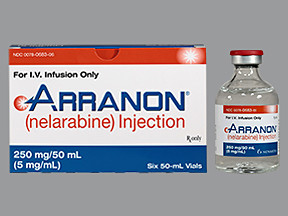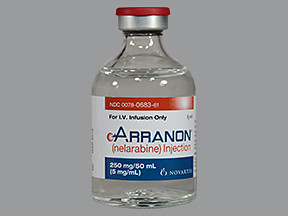NELARABINE - INJECTION
PHONETIC PRONUNCIATION: (nel-AR-a-been)
COMMON BRAND NAME(S): Arranon
GENERIC NAME(S): nelarabine
Uses
USES: This medication is used to treat certain cancers (leukemia, lymphoma). Nelarabine is a chemotherapy drug that works by slowing or stopping the growth of cancer cells.
How to use NELARABINE - INJECTION
HOW TO USE: Read the Patient Information Leaflet provided by your pharmacist before you start using nelarabine and each time you get a refill. If you have any questions, consult your doctor or pharmacist. This medication is given by slow injection into a vein, usually by a health care professional. Each treatment period is called a cycle. In adults, it is usually given on days 1, 3, and 5 of each treatment cycle or as directed by your doctor. In children, it is usually given daily for 5 days in a row during each treatment cycle or as directed by the doctor. The dosage is based on your medical condition, age, body size, and response to treatment. Your doctor will check your blood counts to make sure you can receive your next cycle. Keep all medical and laboratory appointments.
Side Effects
Precautions
Interactions
Overdose
Images
Reviews
Faq for NELARABINE - INJECTION
Nelarabine is an injectable medication that belongs to the class of chemotherapeutic agents known as purine analogues. It is primarily used in the treatment of T-cell acute lymphoblastic leukemia (T-ALL) and T-cell lymphoblastic lymphoma (T-LBL).
Nelarabine works by inhibiting the growth of cancer cells. It is converted to its active form within the cells, where it incorporates into the DNA strands and disrupts their function. This interference with DNA replication and repair ultimately leads to the death of cancerous cells.
Some common side effects of Nelarabine include nausea, vomiting, fatigue, headache, fever, low blood cell counts (anemia, neutropenia, thrombocytopenia), neuropathy (tingling or numbness in hands or feet), and increased liver enzymes. It is important to inform the healthcare provider if any severe side effects occur.
Nelarabine is given as an intravenous (IV) infusion by a healthcare professional. The dosage and frequency of the medication will depend on the individual's specific condition and response to treatment.
Yes, Nelarabine may cause severe toxicities, particularly in the nervous system. It is contraindicated in patients with a history of severe neurologic toxicity with other nucleoside analogues. It may also cause myelosuppression, which can increase the risk of infections and bleeding. Regular blood tests and close monitoring are necessary during treatment.
Warning
WARNING: Infrequently, serious nervous system problems have occurred with the use of this medication. The risk may be increased if you have previously received chemotherapy injection into a certain part of the spine (intrathecal) or radiation treatment to the head/spine area. Tell your doctor right away if you notice any symptoms of nervous system problems including: extreme sleepiness, confusion, numbness/tingling in hands/feet, loss of coordination, muscle weakness, or unsteadiness while walking. Seek immediate medical attention if any of the following symptoms occur: inability to move (paralysis), seizure. These symptoms may not go away completely even when treatment with nelarabine is stopped. Consult your doctor for details.
Disclaimer
IMPORTANT: HOW TO USE THIS INFORMATION: This is a summary and does NOT have all possible information about this product. This information does not assure that this product is safe, effective, or appropriate for you. This information is not individual medical advice and does not substitute for the advice of your health care professional. Always ask your health care professional for complete information about this product and your specific health needs.


No Reviews Yet